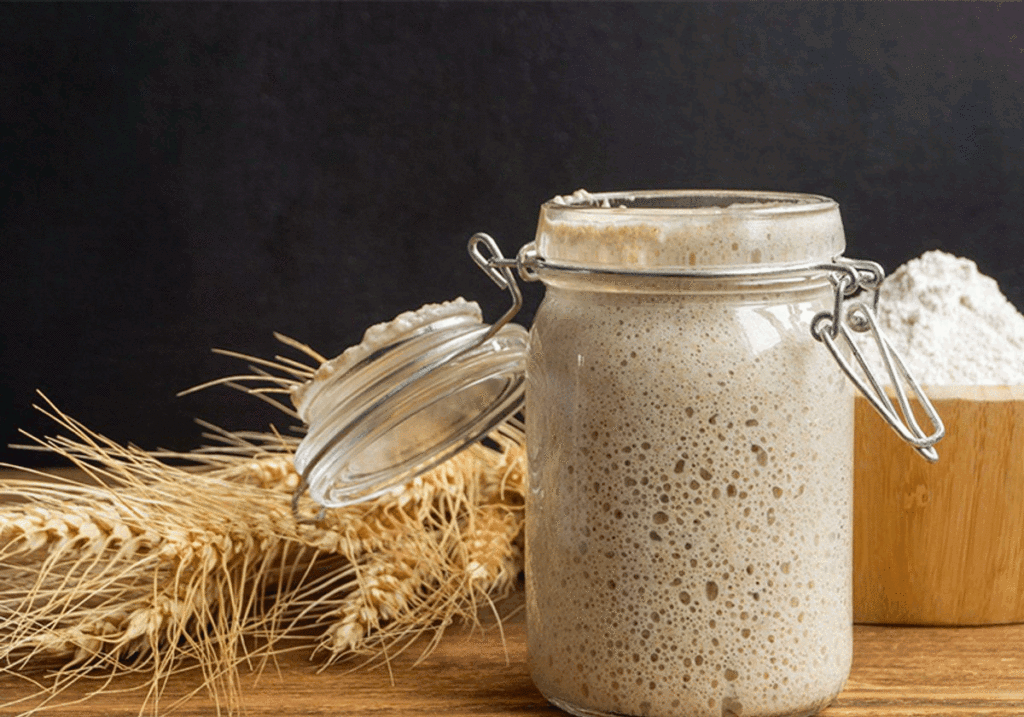밀가루 유형이 사워도우 스타터에 미치는 영향
다양한 사워도우 스타터를 연구하고 미생물의 서열을 분석함으로써 연구원들은 주방과 교실에서 실험을 원하는 사람들에게 유용한 정보를 생성했습니다.
번역 결과
번역 결과
코로나19로 인한 봉쇄 기간 동안 집에 고립된 많은 사람들이 부엌에서 14,000년이 넘는 전통을 재현했습니다.1 단지 밀가루와 물을 단지에 섞어 빵 굽는 사람은 이러한 재료에 달라붙어 있는 휴면 효모와 박테리아를 깨웠고, 이로 인해 가스와 기타 물질이 생성됩니다. 누룩을 만들고 구운 식품에 독특한 풍미를 부여하는 발효 분자. 상업용 효모 부족을 비롯한 전염병 요인으로 인해2 사워도우가 다시 부활했습니다. 제빵사는 주방에서 실험을 하면서 왜 온도와 같은 다양한 발효 조건이 빵의 향이나 맛 프로필을 변화시키는지 궁금해합니다. Erin McKenney와 같은 연구자들은 사워도우 스타터의 특성을 담당하는 미생물 생태계에 대해 궁금해합니다. McKenney는 “[제빵사]는 전체 역학을 뒷받침하는 미생물을 고려하지 않았습니다.”라고 말했습니다. McKenney는 대학원에서 장내 미생물을 연구한 후 노스캐롤라이나 주립대학교(NCSU)의 Robert Dunn 응용 생태학 실험실에서 박사후 연구원으로 재직하면서 교육 및 연구 도구로서 사워도우에 관심을 갖게 되었습니다. McKenney는 “그것은 마치 항아리 속의 위와 같습니다.”라고 말했습니다. “그것은 산성이고 교란이 심한 단순한 시스템입니다. 제가 결코 똥과 내장을 가져갈 수 없는 방식으로 교실에 가져갈 수 있습니다.” “유전자를 삭제하면 성가신 치즈를 파괴하는 곰팡이가 퇴치됩니다”도 참조하세요. 이전에 McKenney는 연구자들이 전 세계 제빵사로부터 기증받은 사워도우 종균의 서열을 분석하는 프로젝트에 참여했습니다.3 놀랍게도 그들은 지리적 위치보다는 종균을 만들고 유지하는 방식이 미생물 개체수에 영향을 미친다는 사실을 발견했습니다. 이 연구를 바탕으로 현재 NCSU의 조교수이자 학부 프로그램 디렉터인 McKenney는 동일한 지리적 위치와 동일한 프로토콜을 사용하여 만든 스타터에 다양한 글루텐 및 글루텐 프리 밀가루를 공급하여 미생물을 분석했습니다. 그녀의 팀 작업은 최근 PeerJ.4에 게재되었습니다. 노스캐롤라이나 주 롤리에 있는 무어 스퀘어 중학교의 교사인 크리스틴 켐프(Kristen Kemp)는 실험실 교실 앞에 서서 유리병에서 배양된 사워도우 배양 냄새를 맡고 있습니다. 노스캐롤라이나 주 롤리에 있는 무어 스퀘어 중학교의 교사인 크리스틴 켐프(Kristen Kemp)를 포함한 시민 과학자들은 다양한 밀가루에서 사워도우 배양균을 재배하고 분석했으며, 나중에 그 안에 있는 미생물을 밝혀내기 위해 서열을 분석했습니다. 로렌 니콜스 10가지 밀가루로 40가지 스타터를 생산하기 위해 McKenney는 자신이 개발한 Sourdough for Science라는 학습 모듈을 교실에서 사용하는 5명의 중학교 교사를 모집했습니다. 그들의 사워도우 프로토콜은 일반적인 레시피5를 기반으로 했으며 기본적인 주방 장비와 쉽게 구할 수 있는 재료만 필요했습니다. McKenney는 “제빵사가 실제로 주방에서 매일 사용하는 프로세스와 관행을 반영하려면 이 프로젝트가 꼭 필요했습니다.”라고 말했습니다. 사용하기 쉽고 낭비를 최소화하기 위해 레시피를 소형화하여 한 스푼씩 동일한 양의 밀가루와 물을 요구했습니다. 교사들은 14일 동안 매일 할당된 스타터를 새로 고치고, 각 스타터의 pH와 최대 높이를 측정하고, 향기를 기록하고, 나중에 박테리아 주민의 16S 리보솜 RNA(rRNA) 서열 분석을 위해 일부를 제거했습니다. 또한 “미라화된 내장 벌레가 고대 식생활의 비밀을 드러낸다”를 참조하십시오. 빵이 만들어지기 전에 스타터는 10~14일 동안 영양분을 소비하고 맛, 냄새 및 미생물 개체수에 영향을 미치는 발효 산물을 배설하는 세 가지 뚜렷한 성장 단계를 거칩니다.6 McKenney 팀은 빵을 만든 지 하루 만에 다음과 같은 사실을 발견했습니다. 실험 결과, 모든 스타터(동일한 밀가루 유형의 스타터 포함)에는 다양한 박테리아 종이 포함되었습니다. 2일부터 6일까지, 서열 분석 결과 모든 스타터에서 더 많은 젖산 생성 박테리아가 나타났으며, 이로 인해 각 병의 pH가 낮아지고 산성 조건에 내성이 없는 다른 종들이 죽었습니다. 스타터가 14일쯤 성숙해짐에 따라 연구원들은 일관된 pH 판독값과 기타 내산성 박테리아 종이 눈에 띄게 증가하는 것을 관찰했습니다. 숙성 기간 동안 향이 바뀌었는데, 실험 시작 시에는 낟알 같은 향이 스타터에서 흘러나오고, 나중에는 신맛과 과일 향이 향기를 풍깁니다. McKenney는 “공급되는 밀가루에 따라 이러한 다양한 사워도우 스타터와 관련된 박테리아 특성이 확실히 다릅니다.”라고 말했습니다. 이는 각 밀가루가 미생물에 제공하는 자원의 차이 때문일 수 있습니다. 예를 들어, 호밀가루는 가장 높은 함량과 가장 많은 박테리아 다양성을 지닌 종균을 생성한 반면, 수수는 가장 신맛이 나는 종균을 생성했습니다. 다양한 곡물과 밀가루는 빵을 먹을 때 미적 경험을 완전히 바꿀 수 있는 다양한 박테리아를 지원할 수 있습니다. -노스캐롤라이나 주립대학교 에린 맥케니(Erin McKenney) 사워도우 전문가이자 환경과학 교수인 Eric Pallant는 “[이 연구는] 세 가지 종류의 밀가루를 공급하는 세 가지 뚜렷한 사워도우 배양을 유지하는 것의 이점에 대해 더 큰 확신을 갖게 해줍니다.”라고 말했습니다.
Allegheny College의 과학성과 지속 가능성. 그러나 Pallant는 테스트된 스타터가 처음 14일 이후에 얼마나 안정적인지 궁금했습니다. “밀가루는 해마다 일관성이 없습니다. 그것은 다른 식물과 다른 형태, 다른 장소에서 나옵니다. 우리 집에 있는 박테리아는 계속 존재할 수 없습니다.”라고 그는 말했습니다. “그럼 흥미로운 질문이겠군요.”
McKenney는 이 연구 결과가 제빵사에게 스타터에 대한 더 나은 이해를 제공하고 다양한 밀가루를 실험하도록 영감을 주기를 희망합니다. “다른 곡물과 밀가루는 빵을 먹을 때 미적 경험을 완전히 바꿀 수 있는 다른 박테리아를 지원할 수 있습니다.”라고 그녀는 말했습니다. “미생물이 이러한 종류의 밀가루를 소화하여 다른 제품을 생산하기 때문입니다.” 가정 주방에서 만들거나 교실에서 교육 도구로 사용하는 경우, 사워도우 실험은 현대인을 고대 세계와 연결합니다.
참고자료
Arranz-Otaegui A, 외. 고고학적 증거를 통해 빵의 기원은 14,400년 전 요르단 북동부에서 밝혀졌습니다. PNAS. 2018;115(31):7925-7930.
Bakalis S, 등. CO+RE의 관점: 코로나19가 식량 시스템과 식량 안보 패러다임을 어떻게 변화시켰는가. Curr 입술 식품 과학. 2020;3:166-172.
Landis EA, 그 외 여러분. 사워도우 스타터 미생물군집의 다양성과 기능. eLife. 2021;10:e61644.
맥케니 EA, 그 외 여러분. 사워도우 스타터는 비슷한 연속 패턴을 보이지만 밀가루 특유의 클라이막스 군집을 형성합니다. PeerJ. 2023;11:e16163.
하멜 P. 사워도우 스타터. 킹 아서 베이킹. 2023년 11월 21일에 액세스함. https://www.kingarthurbaking.com/recipes/sourdough-starter-recipe.
Harth H, 외. 실험실 및 빵집 조건에서 자발적인 백슬로프 보리 사워도우 발효에 대한 공동체 역학 및 대사산물 표적 분석. Int J 식품 미생물. 2016;228:22-32.
공유하다:
FacebookTwitterLinkedInEmail나누
Isolated at home during the covid lockdown, many people reenacted an over 14,000-year-old ritual in their kitchens.1 By simply combining flour and water in jars, bakers awakened the dormant yeast and bacteria clinging to these ingredients, which produce gas and other fermentative molecules that leaven and impart unique flavors in baked goods.
Thanks to pandemic factors including commercial yeast shortages,2 sourdough has seen a resurgence. Bakers experiment in their kitchens and wonder why different fermentation conditions like temperature change the aromatic or flavor profiles of their bread. Researchers like Erin McKenney wonder about the microbial ecosystems responsible for a sourdough starter’s characteristics. “[Bakers] just haven’t considered the microbes that underpin that entire dynamic,” said McKenney.
After studying gut microbes during graduate school, McKenney became interested in sourdough as a teaching and research tool when she was a postdoctoral researcher in Robert Dunn’s applied ecology laboratory at North Carolina State University (NCSU). “It’s like a stomach in a jar,” said McKenney. “It’s acidic, and it’s a simple system [with] high disturbance … You can take it into classrooms in ways that I can never take poop and guts.”
See also “Deleting a Gene Quells a Pesky Cheese-Destroying Fungus”
Previously, McKenney was involved in a project where researchers sequenced sourdough starters donated by bakers around the world.3 Surprisingly, they found that how the starters were made and maintained, rather than the geographic location, affected the microbial populations. To build upon this research, McKenney—now an assistant professor and director of undergraduate programs at NCSU—analyzed the microbes within starters made at the same geographic location and using the same protocol, but fed with various gluten and gluten-free flours. Her team’s work was recently published in PeerJ.4

Citizen scientists including Kristen Kemp, a teacher at Moore Square Middle School in Raleigh, North Carolina, grew and analyzed sourdough cultures from various flours, which were later sequenced to reveal the microbes within.
LAUREN NICHOLS
To produce 40 starters from 10 different flours, McKenney enlisted five middle school teachers who used a learning module that she developed called Sourdough for Science in their classrooms. Their sourdough protocol was based on a common recipe5 and required only basic kitchen equipment and readily available ingredients. “We really needed this project to reflect the processes and practices that bakers are actually using every day in their kitchens,” McKenney said. For ease of use and to minimize waste, they miniaturized the recipe, calling for equal amounts of flour and water by the tablespoonfuls. The teachers refreshed their assigned starters daily for 14 days, measured each starter’s pH and maximum height, recorded aromas, and removed portions for later 16S ribosomal RNA (rRNA) sequencing of the bacterial inhabitants.
See also “Mummified Gut Bugs Reveal Ancient Dietary Secrets”
Before bread can be made, the starters go through three distinct growth phases as they consume nutrients and excrete fermentation products that affect taste, smell, and the microbial populations over the course of 10-14 days.6 McKenney’s team found that one day after starting the experiment, all starters—even those from the same flour type—housed variable bacterial species. During days two through six, the sequencing results showed more lactic acid-producing bacteria in every starter, which lowered the pH in each jar, killing other species that are intolerant to acidic conditions. As the starters reached maturity around day 14, the researchers observed consistent pH readings and other acid-tolerant bacterial species rising to prominence. Aromas changed during the maturation period, with grainy scents wafting out of the starters at the beginning of the experiment, and sour and fruity aromas perfuming later starters. “There are definitely distinctly different bacterial signatures that are associated with these different sourdough starters, based on the flour that they’re fed,” said McKenney. This is likely due to differences in the resources each flour provides to the microbes. For example, rye flour produced starters with the highest rise and most bacterial diversity whereas sorghum created the sourest starter.
Different grains and flours might support different bacteria that can completely change your aesthetic experiences when you’re eating the bread.
-Erin McKenney, North Carolina State University
“[This work] gives me greater confidence in the benefits of maintaining my three distinct sourdough cultures that are fed three different kinds of flour,” said Eric Pallant, a sourdough expert and professor of environmental science and sustainability at Allegheny College. However, Pallant wondered how stable the tested starters would be beyond the first 14 days. “Flour is not consistent year after year; it’s coming from different plants and different forms, in different places. The bacteria in our homes can’t possibly be constant,” he said. “So that would be an interesting question.”
McKenney hopes that the results of this study will give bakers a better understanding of their starters and inspire them to experiment with various flours. “Different grains and flours might support different bacteria that can completely change your aesthetic experiences when you’re eating the bread,” she said. “It’s because the microbes are digesting those flour types to produce different products.” Whether made in home kitchens or used in classrooms as a teaching tool, sourdough experimentation connects modern people to the ancient world.
REFERENCES
- Arranz-Otaegui A, et al. Archaeobotanical evidence reveals the origins of bread 14,400 years ago in northeastern Jordan. PNAS. 2018;115(31):7925-7930.
- Bakalis S, et al. Perspectives from CO+RE: How COVID-19 changed our food systems and food security paradigms. Curr Res Food Sci. 2020;3:166-172.
- Landis EA, et al. The diversity and function of sourdough starter microbiomes. eLife. 2021;10:e61644.
- McKenney EA, et al. Sourdough starters exhibit similar succession patterns but develop flour-specific climax communities. PeerJ. 2023;11:e16163.
- Hamel P. Sourdough Starter. King Arthur Baking. Accessed November 21, 2023. https://www.kingarthurbaking.com/recipes/sourdough-starter-recipe.
- Harth H, et al. Community dynamics and metabolite target analysis of spontaneous, backslopped barley sourdough fermentations under laboratory and bakery conditions. Int J Food Microbiol. 2016;228:22-32.
Share:
FacebookTwitterLinkedInEmail나누기











